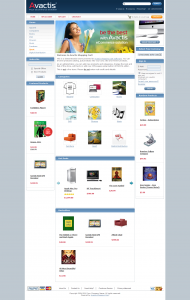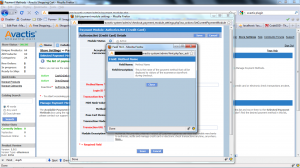Avactis is another in a long line of e-commerce web applications written in php (similar to OpenCart and PrestaCart), this one a little different in that Avactis has different versions, each with different features, depending on how much you're willing to spend. Avactis is a full featured product with all the bells and whistles any ambitious store would need (and then some more features stacked on top for good measure) combined with a very php like integration methodology. Unfortunately, the dated administration interface combined with a lack of a plugin architecture and theme community really holds it back from the awesome bar.
For the uninitiated, Avactis is created and maintained by Pentasoft Corp; oddly, there's no website for the parent company so take that for what you will. As mentioned, Avactis is based on a pay model though it's way more upfront about it than PrestaCart and, while the free version is missing some features, the source is available for modifications. Not too bad in my opinion; at least the more cash strapped shops can still play if they want to.
The different versions of Avactis are Free, Owned ($199), Monthly Leased ($19.95 a month) and White Label ($299) each with their own features and options. Most notably the Free version doesn't include any (useful) payment modules (Authorize.net anyone?), coupon module, data export and import, quantity discounts or search engine friendly URLs out of the box. They do offer discounts for web developers though (at least 50% and they say up to 100%), and the complete source is available without obfuscation, so at least those functions that are needed can be added which can really ease the pain of paying for the thing in my opinion.
As expected, Avactis has the ability for custom themes though I'm disappointed to see that there doesn't appear to be any theme community in existence (compared to other cart software packages). The reasoning behind this is probably because Avactis bills itself as being "easy integration with an existing website thanks to unique Avactis tag technology". And by unique they mean including a php file and calling php function snippets. I'm all for marketing hype but wtf is that?!? Here's an example:
<?php include('init.php'); ?>
<?php NavigationBar(); ?>
<?php Breadcrumb(); ?>
<?php ProductList(); ?>
It's called php and EVERY php site does this Avactis not just you. Essentially though, this isn't a bad strategy and, in fact, is definitely a strength especially without all the hyperbole. Obviously, Avactis can stand alone and doesn't need to be integrated into a separate site but it's a good idea to allow easy integration into existing sites.
Avactis is packed with all the features any online store would want; content management system, coupon and discount mechanisms, order and customer management, packing slip builder to name a few. Each feature is also highly customizable and usually includes a plethora of options and settings; nice if you build complex product build outs or specific functionality. On the other hand though, this amount of features and customization comes at a cost in terms of ease of use, work flow and a lacking user friendly experience.
The administration interface for Avactis is a nightmare mess of pop-up windows, tabs and accordion widgets. Slick is not a word I would use to describe the experience. Functional or crappy or painful or eyebleedingworstinterfaceeverpleasekillmefortheloveofgod!; those are better words to describe it.
There's inconsistencies all over the place; for example while editing a product the help widgets will open another pop-up window (sigh...) yet in the main menu hovering over a link will display a tool tip and in the installation process the help widgets are all inline divs.
Going through the code yields such codesod qualifiers as the below:
<?php
/**
* Defines the possibility of uploading images by file type.
*
* @param $file The array consists of the $_FILES variable, for
* the current file.
* @return boolean
*/
function isAllowedImageType($file)
{
/* $type = _ml_strtolower($file);
switch ($type)
{
case 'image/gif':
case 'image/jpeg':
case 'image/jpg':
case 'image/jpe':
case 'image/jfif':
case 'image/pjpeg':
case 'image/pjp':
case 'image/png':
case 'image/x-png':
return true;
default:
return false;
}
*/
return true;
}
?>
If that doesn't make any sense to you suffice it to say that the above function is supposed to verify that an image's mime type matches the list; unfortunately though, the function is, what we call "commented out" and will not be executed. All files sent to the function will validate as true so, essentially, any file type can be uploaded. While it's entirely possible this is an old function that was replaced with something useful, and it should be noted that I never found any calls to that function (but I really didn't look too hard), the fact that it's still in the code-base speaks volumes, to me, about the project maintenance at the very least.
On top of that Avactis has one of the most wasteful and useless installation processes I've ever seen. Initially, Avactis ships with a very minimal file set that includes a 15 mega byte (MB) file whose sole purpose is to contain all additional files in a gzipped and base64 encoded string. The sole purpose of this is to allow Avactis to programmatically write all source files to the file system during installation. For the life of me I can't imagine what functional requirement precipitated this design decision. Considering the complexity added to the development cycle this would cause it makes no sense to me; I'm at a loss. I could be missing something though; you never know it may have a really sick benefit that I'm just not privy to.
Are any of those "issues" at all relevant? Not the function and not the installation process. Those are subjective issues that may only matter to me; it's armchair quarterbacking at it's finest (if I do say so myself). For everything else, well, that obviously depends on the specific needs of the project. For my needs it's a pass simply because my clients care about the interface and Avactis looks like it hasn't been updated since 2002 (at least).
So, while Avactis is a nice program with all of the features any store would ever need I personally feel that it's not ready for my project.



